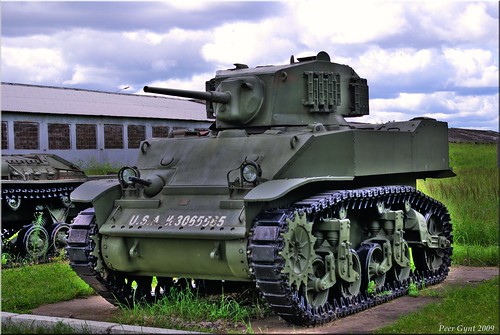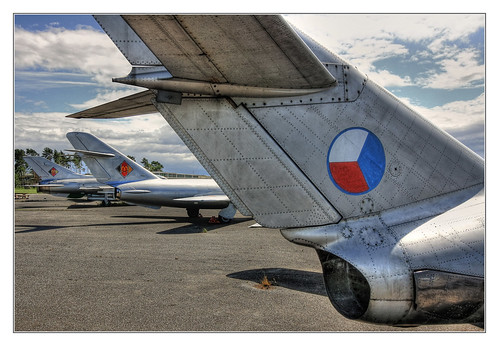Check out these china machined components photos:
M5A1 (Stuart VI) Light Tank. 1941- 43.

Image by Peer.Gynt
Moscow. Kubinka Tank Museum.
The M3 Stuart, formally Light Tank M3 was an American light tank of Globe War II. It was employed by British and Commonwealth forces prior to the entry of the USA into the war, and thereafter by US and Allied forces until the finish of the war. The name Basic Stuart or Stuart provided by the British comes from the American Civil War Basic J.E.B. Stuart and was used for each the M3 and M5 Light Tank in British service it also had the unofficial nickname of Honey. To the United States Army the tanks were officially known only as Light Tank M3 and Light Tank M5.
History
Observing events in Europe, American tank designers realized that the Light Tank M2 was becoming obsolete and set about improving it. The upgraded style, with thicker armor, modified suspension and new gun recoil technique was named "Light Tank M3". Production of the automobile started in March 1941 and continued until October 1943. Like its direct predecessor, the M2A4, the M3 was armed with a 37 mm M5 gun and five .30-06 Browning M1919A4 machine guns: coaxial with the gun, on prime of the turret in an M20 AA mount, in a ball mount in proper bow, in the right and left hull sponsons.
To relieve the demand for the radial aero-engines used in the M3, a new version was developed making use of twin Cadillac V-eight automobile engines. The new model (initially called M4 but redesignated M5 to avoid confusion with the M4 Sherman) also featured a redesigned hull with sloped glacis plate and driver’s hatches moved to the leading. Even though the primary criticism from the utilizing units was that the Stuarts lacked firepower, the improved M5 series kept the identical 37 mm gun. The M5 progressively replaced the M3 in production from 1942 and was in turn succeeded by the Light Tank M24 in 1944.
Combat history
Light Tank M5A1 passes by means of the wrecked streets of Coutances.
An Australian Stuart I for the duration of the final assault on Buna.
A British M3 (Stuart I) knocked out for the duration of fighting in North Africa.The British Army was the first to use the Light Tank M3 as the "General Stuart" in combat. In November 1941, some 170 Stuarts took component in Operation Crusader, with poor final results. Though the high losses suffered by Stuart-equipped units throughout the operation had a lot more to do with far better techniques and coaching of the Afrika Korps than the apparent superiority of German armor in the North African campaign, the operation revealed that the M3 had numerous technical faults. Talked about in the British complaints were the 37 mm M5 gun and poor internal layout. The two-man turret crew was a significant weakness, and some British units attempted to fight with three-man turret crews. The Stuart also had a restricted variety, which was a severe issue in desert warfare as units typically outpaced their supplies and were stranded when they ran out of fuel. On the optimistic side, crews liked its higher speed and mechanical reliability, hence its unofficial nickname of Honey. The high speed and higher reliability distinguished the Stuart from cruiser tanks of the period, in distinct the Crusader, which composed a large portion of the British tank force in Africa up till 1942.
From the summer season of 1942, when adequate US medium tanks had been received, the British typically kept Stuarts out of tank-to-tank combat, utilizing them primarily for reconnaissance. The turret was removed from some examples to save weight and increase speed and range. These became known as "Stuart Recce". Some other folks had been converted to armored personnel carriers and have been identified as "Stuart Kangaroo", and some have been converted command vehicles and identified as "Stuart Command". M3s, M3A3s, and M5s continued in British service till the end of the war, but British armor units had a smaller proportion of these light tanks than US units.
The other major Lend-Lease recipient of the M3, the Soviet Union, was even less content with the tank, contemplating it undergunned, underarmored, likely to catch fire, and as well sensitive to fuel good quality. The narrow tracks had been hugely unsuited to operation in winter conditions, as they resulted in high ground pressures that sank the tank into the snow. Also, the M3’s radial aircraft engine needed high-octane fuel, which complex Soviet logistics as most of their tanks utilized diesel. Nonetheless, the M3 was superior to early-war Soviet light tanks such as the T-60, which were often underpowered and possessed even lighter armament than the Stuart. In 1943, the Red Army attempted out the M5 and decided that the upgraded design wasn’t significantly better than the M3. Being much less desperate than in 1941, the Soviets turned down an American supply to supply the M5. M3s continued in Red Army service at least till 1944.
In US Army service, the M3 first saw combat in the Philippines. Two battalions, comprising the Provisional Tank Group fought in the Bataan peninsula campaign. When the American army joined the North African Campaign in late 1942, Stuart units nonetheless formed a massive component of its armor strength. Soon after the disastrous Battle of the Kasserine Pass the US rapidly followed the British in disbanding most of their light tank battalions and subordinating the Stuarts to medium tank battalions performing the traditional cavalry missions of scouting and screening. For the rest of the war, most US tank battalions had three firms of M4 Shermans and a single company of M3s or M5/M5A1s.
In the European theater, Allied light tanks had to be given cavalry and infantry fire support roles considering that their primary cannon armament could not compete with heavier enemy AFVs. However, the Stuart was nevertheless efficient in combat in the Pacific Theater, as Japanese tanks have been each reasonably uncommon and were typically a lot weaker than even Allied light tanks. Japanese infantrymen have been poorly equipped with anti-tank weapons and tended to attack tanks employing close-assault techniques. In this atmosphere, the Stuart was only moderately a lot more vulnerable than medium tanks. In addition, the poor terrain and roads frequent to the theatre had been unsuitable for the significantly heavier M4 medium tanks, and so initially, only light armor could be deployed. Heavier M4s had been at some point brought to overcome heavily entrenched positions, although the Stuart continued to serve in a combat capacity till the finish of the war.
Although the Stuart was to be totally replaced by the newer M24 Chaffee, the number of M3s/M5s created was so great (more than 25,000 such as the 75 mm HMC M8) that the tank remained in service till the end of the war and well after. In addition to the United States, United Kingdom and Soviet Union, who were the major customers, it was also used by France, China (M3A3s and, quickly post-war, M5A1s) and Tito’s partisans in Yugoslavia (M3A3s and few M3A1).
Following the war, some nations chose to equip their armies with cheap and trustworthy Stuarts. The Republic of China Army, getting suffered excellent attrition in terms of armors as a outcome of the ensuing civil war, rebuilt their armored forces by acquiring surplus vehicles left behind in the former PTO by the US forces, which includes 22 M5A1s to equip two tank companies. They would have their finest hours throughout the Battle of Kuningtou, for which the tank came to be known as the "Bear of Kinmen" (金門之熊). The M5 played a considerable role in the 1st Kashmir War (1947) among India and Pakistan, which includes the battle of Zoji-la pass at an amazing altitude of almost 12,000 ft. The automobile remained in service in several South American nations at least until 1996.
Throughout the 60s and 70s, the Portuguese Army also used some in the war in Angola, exactly where its all terrain capability (compared to wheeled cars) was tremendously appreciated.
Production history
Produced 1941-1943
Specifications
Weight 14.7 tonnes (32,400 lb)
Length four.5 m (14.8 ft)
Width two.46 m (8.1 ft)
Height 2.3 m (7.5 ft)
Crew four (Commander, gunner, driver, co-driver)
——————————————————————————–
Armor 13 – 51 mm
Primary
armament 37 mm M6 in M44 mount
174 rounds
Secondary
armament 3 x .30-06 Browning M1919A4 MG
7,500 rounds
Engine Continental W-670-9A, 7 Cylinder air-cooled radial
250 hp (186 kW)
Power/weight 17.82 hp/tonne
Suspension Vertical volute spring
Operational
range 120 km (74 mi)
Speed 58 km/h (36 mph) (road)
30 km/h (18 mph) (off-road)
From Wikipedia, the totally free encyclopedia
en.wikipedia.org/wiki/M3_Stuart
Berlin – Militärhistorisches Museum Flugplatz Berlin-Gatow – MiG tailpieces

Image by Daniel Mennerich
Russian Aircraft Corporation MiG (Российская самолетостроительная корпорация «МиГ»), or RSK MiG, is a Russian joint stock business. Formerly Mikoyan-and-Gurevich Design Bureau (Russian: Микоян и Гуревич, МиГ), then basically Mikoyan, it is a military aircraft design bureau, mainly designing fighter aircraft. Its head office is in Begovoy District, Northern Administrative Okrug, Moscow.
It was formerly a Soviet design bureau, and was founded by Artem Mikoyan and Mikhail Gurevich as "Mikoyan and Gurevich", with the bureau prefix "MiG." Upon Mikoyan’s death in 1976, Gurevich’s name was dropped from the name of the bureau, despite the fact that the bureau prefix remained "MiG". The firm also operates many machine-creating and design bureaus, which includes the Kamov helicopter plant.
MiG aircraft are a staple of the Soviet and Russian air forces, and the Soviet Union sold numerous of these aircraft inside its sphere of influence. They have been utilized by the militaries of China, North Korea, and North Vietnam in aerial confrontations with American and allied forces, and form portion of the air forces of several Arab nations.
In 2006, the Russian government merged 100% of Mikoyan shares with Ilyushin, Irkut, Sukhoi, Tupolev, and Yakovlev as a new organization named United Aircraft Corporation.
Specifically, Mikoyan and Sukhoi were placed within the same operating unit.
(Post from rapid prototyping companies in china blog)
